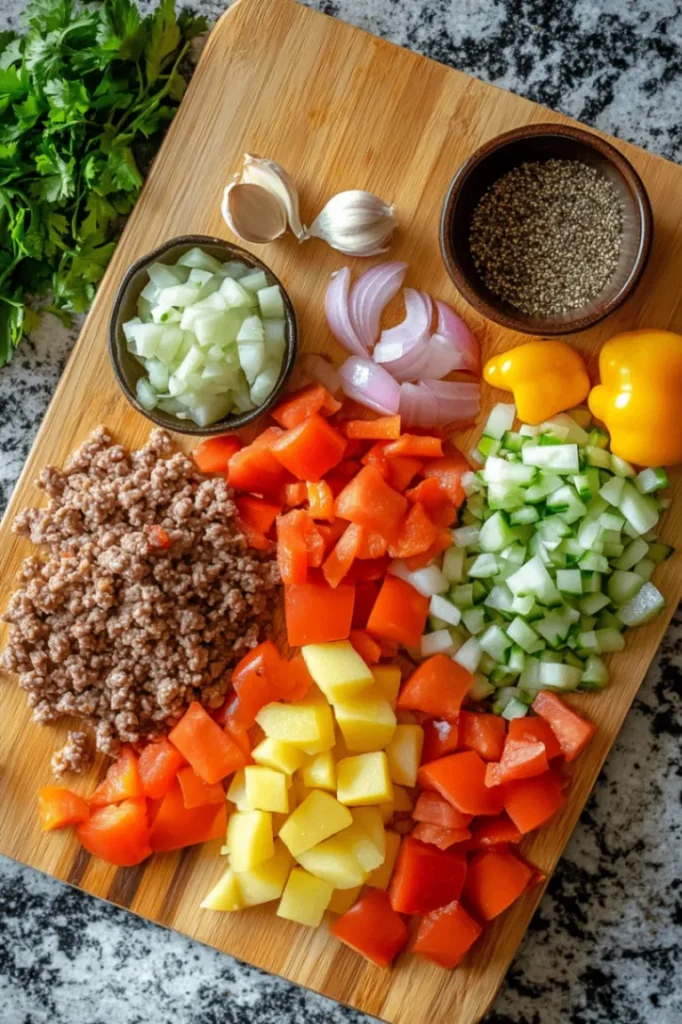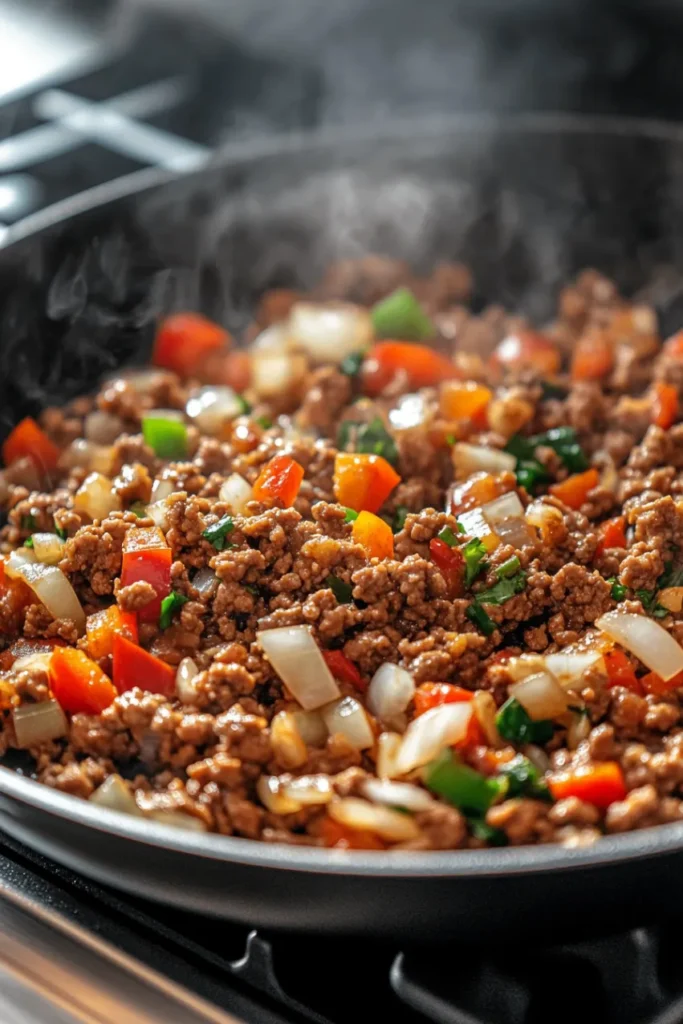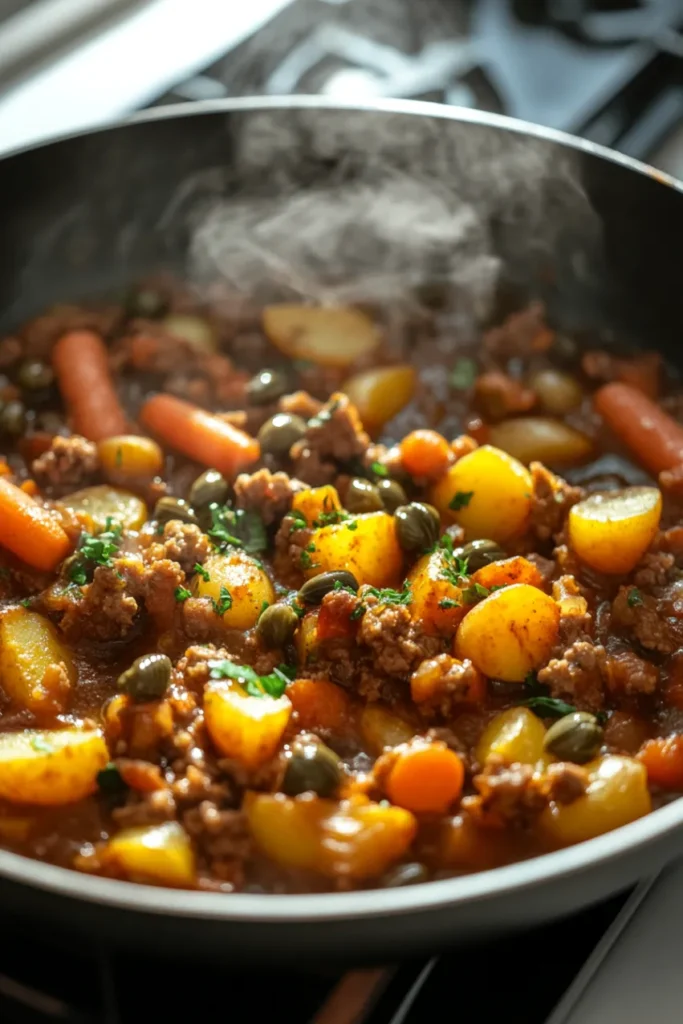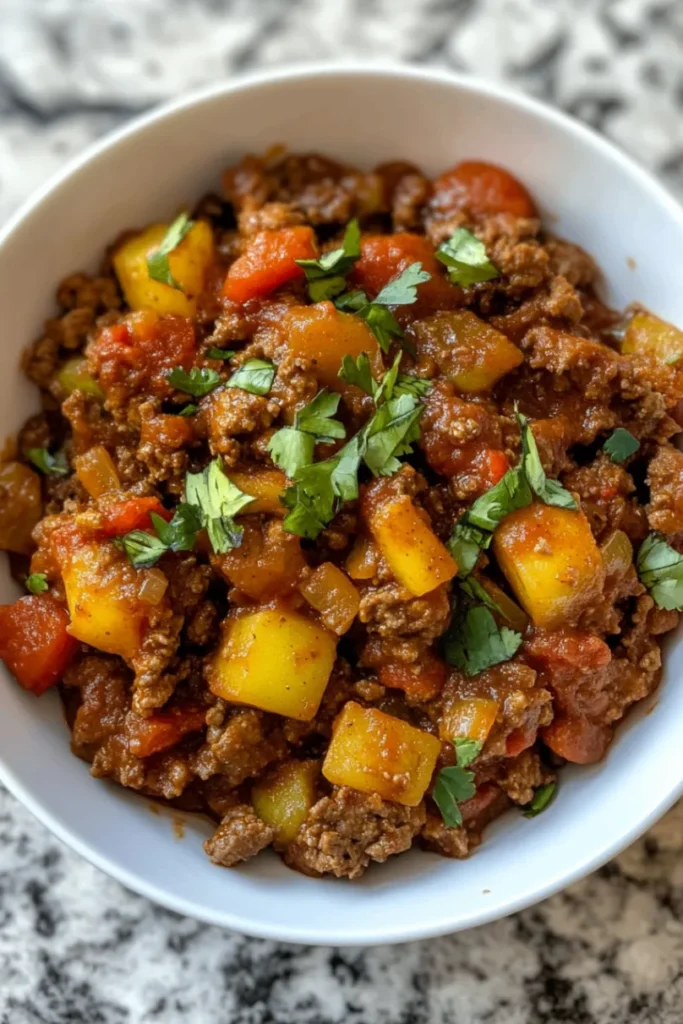Table of Contents
It wasn’t planned, and that’s what made it special. I stumbled upon picadillo during a restless afternoon, flipping through an old cookbook more out of distraction than intent. The ingredients were humble ground meat, tomatoes, and spices, but something about it called to me. Maybe it was the promise of something both bold and comforting, or maybe I just needed a win that day.
As I cooked, the rhythm of chopping, stirring, and seasoning slowly eased the noise in my mind. The kitchen, usually a place of routine, began to feel like a refuge. The smell of simmering sauce and sweet undertones filled the air, carrying with it a quiet kind of reassurance. When I finally sat down to eat, it wasn’t just a meal, it was a moment of calm, of connection, of rediscovery.
Since then, picadillo has become more than a dish in my rotation. It’s a reminder that even in the middle of chaos, small acts like cooking something from the heart can bring us back to ourselves.
Key Benefits of the Picadillo Recipe
Picadillo is more than just a meal it’s an experience packed with benefits that elevate it above the ordinary. Here are some key advantages of incorporating this dish into your weekly routine:
- Nutritional Balance:
- Rich in protein from lean ground beef or turkey alternatives, ensuring you get essential amino acids.
- Abundant in vegetables such as tomatoes, bell peppers, and carrots, which provide vitamins, antioxidants, and dietary fiber.
- Comfort and Warmth:
- The harmonious blend of spices and herbs creates a soothing, home-cooked flavor that can brighten even the gloomiest day.
- Perfect for chilly evenings, offering a warm embrace in every bite.
- Versatility:
- Suitable as a main dish or a filling for tacos, empanadas, or stuffed peppers.
- Easily adjustable for various dietary needs, such as low-sodium or gluten-free options.
- Cultural Connection:
- Picadillo has deep roots in Latin American and Spanish cuisines, connecting you to rich culinary traditions and family heritage.
- A dish that fosters community and conversation around the dinner table, as shared meals often do.
- Ease of Preparation:
- With simple, readily available ingredients and straightforward steps, this recipe is ideal for both novice cooks and seasoned chefs.
- Minimal preparation time makes it a go-to option for busy weeknights without compromising on flavor.
Studies and surveys among home cooks indicate that dishes like picadillo not only contribute to a balanced diet but also significantly enhance overall mood and satisfaction in daily life. Whether you’re cooking for family or experimenting in your own kitchen, the benefits of this recipe extend well beyond its taste, reinforcing the idea that food truly nourishes both body and soul.
Ingredients
Below is a detailed list of ingredients for an authentic, yet adaptable, picadillo recipe. Each component has been thoughtfully selected to ensure a harmonious flavor profile.
| Ingredient | Quantity | Notes |
|---|---|---|
| Lean ground beef | 1 lb | For a hint of natural sweetness, can be omitted if you prefer less sweet flavor. |
| Yellow onion | 1 large | Finely chopped for even cooking and added sweetness. |
| Garlic cloves | 3-4 | Minced to release maximum flavor and aroma. |
| Tomatoes (diced) | 2 cups | Fresh or canned, ensuring no added salt or preservatives if possible. |
| Red bell pepper | 1 medium | Diced for a vibrant pop of color and extra crunch. |
| Green bell pepper | 1 medium | Diced; provides a subtle, earthy flavor that complements the tomatoes. |
| Carrots | 2 medium | Finely chopped or grated to blend seamlessly into the dish. |
| Potatoes | 2 medium | Cubed; optional for a heartier, more filling version of the dish. |
| Raisins | ½ cup | Ground contributes to the classic picadillo flavor. |
| Capers | 2 tablespoons | Rinsed; adds a tangy burst that brightens the overall flavor. |
| Fresh parsley | ¼ cup (chopped) | For garnish and a fresh herbal note. |
| Olive oil | 2 tablespoons | Used for sautéing; enhances the overall taste profile. |
| Salt & Pepper | To taste | Essential for seasoning; adjust as needed. |
| Cumin | 1 teaspoon | Ground; contributes to the classic picadillo flavor. |
| Paprika | 1 teaspoon | Adds a subtle smokiness and vibrant color. |

Each ingredient in this table has been chosen for its ability to contribute to a well-rounded, delicious dish. From the robust flavors of garlic and cumin to the sweet hints of raisins and the brightness of capers, every component plays a vital role in creating an unforgettable meal.
Step-by-Step Instructions
Crafting a delicious picadillo is a rewarding culinary adventure that unfolds in three primary phases. Each phase builds upon the previous one, ensuring a well-layered and satisfying flavor profile.
Phase 1: Preparation and Sautéing
- Gather and Prepare Your Ingredients:
Begin by organizing your ingredients on your workspace. Clean and dice the onions, mince the garlic finely, and chop the bell peppers, carrots, and potatoes into consistent, bite-sized pieces. Uniformity in these cuts is key to achieving even cooking and balanced textures. - Preheat and Oil Your Pan:
Warm up a large skillet or heavy pot over medium heat. Add a measured amount of olive oil and let it warm thoroughly. This step creates the ideal base for releasing the flavors of the aromatics. - Develop the Flavor Base:
Introduce the diced onions to the heated oil and sauté them until they achieve a soft, translucent look with a subtle hint of golden color. Followed by adding the minced garlic and stirring continuously for about a minute. This stage lays the foundation for the robust flavors to follow. - Brown Your Protein:
Add your lean ground beef or a ground turkey substitute to the skillet. Break the meat into small crumbles as it cooks, allowing it to brown evenly and release its juices. The sizzling sounds and aromas will signal that your dish is building its savory essence.

Phase 2: Combining Ingredients and Simmering
- Merge Vegetables and Spices:
Once the meat is nicely browned, incorporate the diced tomatoes, red and green bell peppers, carrots, and potatoes into the pan. Stir the mixture well so that every piece is coated with the emerging flavors. Next, introduce your blend of spices: cumin, paprika, salt, and pepper, ensuring they are evenly distributed. - Introduce the Sweet and Tangy Accents:
Fold in the raisins and capers. The raisins contribute a gentle, natural sweetness that harmonizes with the savory elements, while the capers add a slight tang, enhancing the overall depth of flavor. - Simmer to Perfection:
Lower the heat to a gentle simmer by setting your burner to a low setting, then cover the pan with a lid. This controlled simmering phase, lasting approximately 25 to 30 minutes, allows the ingredients to meld their flavors. Stir occasionally, ensuring that nothing sticks to the bottom and every component is thoroughly infused with the seasoning. If you desire a slightly looser consistency, add a splash of low-sodium broth or water during the process. - Taste and Adjust:
Throughout the simmering period, take a moment to taste the dish. This step is essential to fine-tune the seasoning. Adjust salt, pepper, or spices as needed to match your flavor preference.

Phase 3: Finishing and Presentation
- Final Flavor Enhancement:
Once the vegetables have softened and the meat has absorbed the spices, remove the pan from the heat source. Stir in a generous amount of freshly chopped parsley to inject a burst of freshness and vivid color into the dish. - Resting Time:
Allow your picadillo to sit for a few minutes. This resting period lets the flavors settle and intensify, ensuring that each bite is perfectly balanced and satisfying. - Plating Your Dish:
Carefully transfer the finished picadillo into a serving bowl. For a polished presentation, you might add an extra sprinkle of parsley or a light drizzle of olive oil. Serve alongside complementary sides such as steamed rice, black beans, or a crisp green salad for a complete meal.

Recipe Variations
Picadillo is a versatile dish that welcomes creative modifications to suit a variety of tastes and dietary needs. Here are some inventive twists to customize your dish:
- Vegetarian Adaptation:
- Replace the meat with a mix of finely chopped mushrooms, lentils, or black beans.
- Introduce additional vegetables such as zucchini or spinach to maintain the heartiness of the dish.
- Spicy Infusion:
- For those who appreciate a bit of heat, add finely chopped jalapeños or a pinch of red chili flakes during the initial sauté.
- Adjust the spice level gradually, ensuring the dish remains balanced between heat and its inherent sweetness.
- Low-Carb Option:
- Omit starchy vegetables like potatoes and increase the use of low-carb alternatives such as bell peppers and zucchini.
- Serve with a side of cauliflower rice as a nutritious substitute for traditional rice.
- Mediterranean Variation:
- Enhance the dish with Mediterranean ingredients by adding artichoke hearts, sun-dried tomatoes, and a sprinkle of oregano.
- Swap out raisins for chopped dried figs to achieve a slightly different sweet profile.
- Budget-Friendly Version:
- Utilize cost-effective cuts of meat or opt for a plant-based protein blend, along with seasonal vegetables.
- This version maintains vibrant flavors while keeping the dish economical.
Each of these variations offers an opportunity to experiment and personalize your picadillo. By making these adjustments, you can cater to diverse dietary needs or simply keep your weekly menu exciting. Whether you lean towards a heartier meat-based dish or a creative plant-forward twist, the foundational technique remains the same building layers of flavor through careful preparation and patient cooking.
Serving Suggestions
Picadillo is incredibly versatile, making it easy to serve in a variety of appetizing ways. Whether you prefer a wholesome home-style dinner or a creative twist, consider these suggestions for a balanced, delicious plate:
- Rice Foundation:
Spoon the hearty mixture over warm white or brown rice. The mild flavor of the grains absorbs the dish’s seasoning, creating a comforting base that showcases the savory nuances of the stew. - Hearty Legumes:
Pair your picadillo with lightly seasoned beans such as black, pinto, or kidney beans. Their earthy taste offers a pleasant contrast to the bright, tangy notes often found in this dish. - Bright Side Salad:
Combine fresh greens like romaine or mixed lettuce with thinly sliced cucumber, cherry tomatoes, and a light vinaigrette. This crisp side counters the richness of the stew and adds a burst of color to your meal. - Roasted Vegetable Medley:
Place slices of zucchini, carrots, bell peppers, and onions on a sheet pan, drizzle with a bit of olive oil, sprinkle with salt and pepper, then roast until golden. These caramelized vegetables work beautifully alongside picadillo’s simmered flavors. - Plantain Accents:
Sweet or lightly fried plantain slices bring a contrasting flavor that complements the savory core of the dish. They add a welcome element of texture and just enough sweetness to round out every bite.
Tips for Success
Achieving a sumptuous picadillo revolves around a few simple but important practices:
- Consistent Chopping:
Dice your vegetables and proteins into similar sizes. This uniformity ensures even cooking, so no piece ends up too soft or underdone. - Layered Cooking:
Start by sautéing aromatics such as onions, garlic, and peppers to form a flavorful base. Add ground meat next, followed by vegetables, and finally incorporate spices or herbs. Building in stages deepens the overall taste. - Simmer with Care:
After everything is combined, reduce your burner to a low or medium-low setting. A gradual simmer allows flavors to mingle without any single element overwhelming the dish. - Taste and Adjust:
Sample the stew periodically. If it needs more brightness, consider a small pinch of salt or a dash of your preferred spice. Making minor tweaks over time keeps the flavor balanced. - Resting Period:
Let your finished stew sit for a few minutes before plating. This short break helps the taste settle and ensures each spoonful has a fully developed flavor.
Enhancing Flavor and Variety
Picadillo thrives on innovation. You can adapt this dish to your taste or local ingredients by trying new seasonings and fresh combinations. Here are some thoughtful ideas:
- Spice Exploration:
While cumin and paprika often form the backbone of the recipe, feel free to add a tiny amount of chili powder if you prefer a kick, or a sprinkle of dried oregano for a herby undertone. A light dusting of ground cinnamon can also lend warmth without overpowering other flavors. - Regional Influences:
Embrace local produce or garnishes that resonate with regional cuisine. A squeeze of lime can brighten every bite, while sliced olives might provide a tangy, briny note. Experiment with any fresh herbs or peppers found at your local market. - Boosted Nutrition:
Stir in chopped leafy greens like spinach or Swiss chard during the final moments of cooking. This move adds color, vitamins, and a gentle texture that harmonizes with the heartiness of the stew. - Meal Prepping:
Prepare a generous batch and portion it into airtight containers for the week. Picadillo often grows even more flavorful after a day or two, making it a perfect choice for busy schedules. - Texture Play:
A final flourish of toasted nuts (pecans, almonds, or walnuts) or seeds (pumpkin seeds, sunflower seeds) just before serving can introduce an unexpected crunch that elevates the dish.
Frequently Asked Questions (FAQ)
What are the ingredients in picadillo?
A classic version typically includes ground meat (often beef or turkey), diced onions, bell peppers, carrots, and occasionally potatoes. The stew is usually enriched with tomatoes or tomato sauce, plus a balance of sweet and tangy elements like raisins or capers to bring out its signature taste. Common seasonings include cumin, paprika, salt, and pepper.
What is the difference between Mexican picadillo and Cuban picadillo?
Both styles start with the same general concept ground meat and diced vegetables, but the Mexican version tends to incorporate more spice or chili peppers, creating a bolder, more intense heat. In contrast, the Cuban approach prioritizes a gentle sweetness and aromatic quality, often achieved through abundant raisins and capers.
What spices are in picadillo?
Although cumin and paprika are common fixtures, cooks may also add salt, pepper, oregano, or other herbs. Every household has its own preferences, so you might discover recipes that include hints of garlic powder, chili powder, or even cinnamon for extra warmth.
What is a Cuban picadillo?
In Cuban-style picadillo, the dish leans toward a mildly sweet profile and aromatic notes. It uses a similar base of meat and vegetables, but is distinguished by a generous helping of raisins and capers. This combination creates a unique balance of savory, sweet, and tangy elements that is especially beloved in Cuban cuisine.
Conclusion
Picadillo remains a comforting favorite thanks to its adaptable nature, rich seasoning, and satisfying blend of textures. With a little creativity, you can easily customize it to reflect your personal preferences, cultural influences, or dietary needs. Whether you serve it over rice, pair it with roasted vegetables, or give it a zesty twist using fresh herbs, this dish brings warmth and heartiness to the table. By following the practical tips and exploring the suggested variations, you’ll be well on your way to crafting a picadillo recipe that is uniquely your own. Enjoy the process and savor every flavorful bite!
Print
Picadillo Recipe
- Total Time: 45 minutes
- Yield: 4 servings 1x
- Diet: Gluten Free
Description
This comforting picadillo brings together tender ground meat, sweet raisins, and tangy capers in a hearty tomato base. Packed with veggies and mild spices, it’s a crowd-pleasing meal that feels like a warm hug on a busy weeknight or for a cozy family dinner.
Ingredients
Picadillo Base
- 1 tablespoon olive oil
- 1 pound lean ground beef (or ground turkey for a lighter option)
- 1 large onion, finely diced
- 3 garlic cloves, minced
- 1 cup diced tomatoes (fresh or canned)
- 1 cup diced bell peppers (any color)
- 1 cup diced carrots
- 1 cup diced potatoes (optional for a heartier meal)
- ½ cup raisins
- 2 tablespoons capers, drained
- 1 teaspoon ground cumin
- 1 teaspoon paprika
- 1 teaspoon salt (adjust to taste)
- ½ teaspoon black pepper (adjust to taste)
- 1 cup low-sodium beef or chicken broth (or water)
Optional Garnish
- Chopped fresh parsley or cilantro
- Lime wedges
Instructions
Sauté the Aromatics
- Warm the olive oil in a large skillet or Dutch oven over medium heat.
- Add the diced onion and minced garlic. Cook for 2–3 minutes, stirring often, until the onions turn translucent.
Brown the Ground Meat
- Add the ground beef (or turkey) to the skillet.
- Break it up with a spoon as it cooks, allowing it to brown evenly.
- Season lightly with a pinch of salt and pepper.
Introduce Veggies & Seasonings
- Toss in the diced tomatoes, bell peppers, carrots, and potatoes (if using).
- Stir in cumin, paprika, the remaining salt, and black pepper.
- Continue to sauté for another 2–3 minutes.
Simmer with Broth
- Pour in the broth (or water) to deglaze the pan, scraping up any browned bits from the bottom.
- Gently fold in the raisins and capers.
- Reduce the heat to low, cover the skillet, and let the picadillo simmer for about 15–20 minutes, or until the vegetables are tender and the flavors meld.
Taste & Adjust
- Remove the lid and taste the sauce.
- Add more salt, pepper, or spices if desired.
- If the mixture is too thick, stir in a splash more broth or water.
Garnish & Serve
- Turn off the heat.
- If desired, sprinkle chopped fresh parsley or cilantro over the top for a bright finish.
- Serve hot with steamed rice, a side salad, or warm tortillas.
Notes
✔ Substitutions: Ground turkey or chicken can be used instead of beef for a lighter version. Swap potatoes for sweet potatoes or another root vegetable for a fun twist.
✔ Storage: Store leftovers in an airtight container in the refrigerator for up to 3 days.Reheat gently on the stove or in the microwave, adding a small splash of water or broth if needed.
✔ Serving Ideas: Enjoy picadillo with white rice, quinoa, or even mashed potatoes.Try using leftovers as a filling for tacos or empanadas.
- Prep Time: 15 minutes
- Cook Time: 30 minutes
- Category: Main Course
- Method: Stove-Top Simmer
- Cuisine: Latin American
Nutrition
- Serving Size: 1
- Calories: 300 kcal
- Sugar: 7g
- Sodium: 600mg
- Fat: 12g
- Carbohydrates: 22g
- Protein: 25g
Keywords: Picadillo , Comfort Food , One-Pot Meal , Weeknight Dinner , Latin American Cuisine , Gluten-Free Friendly

